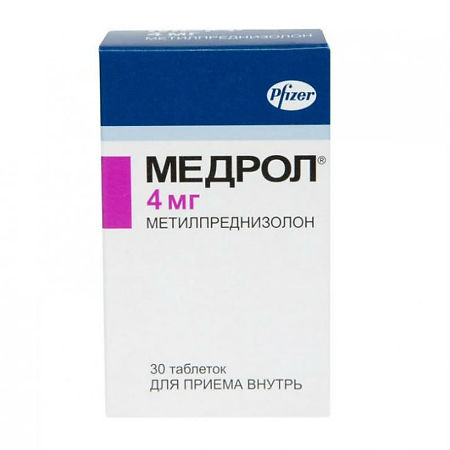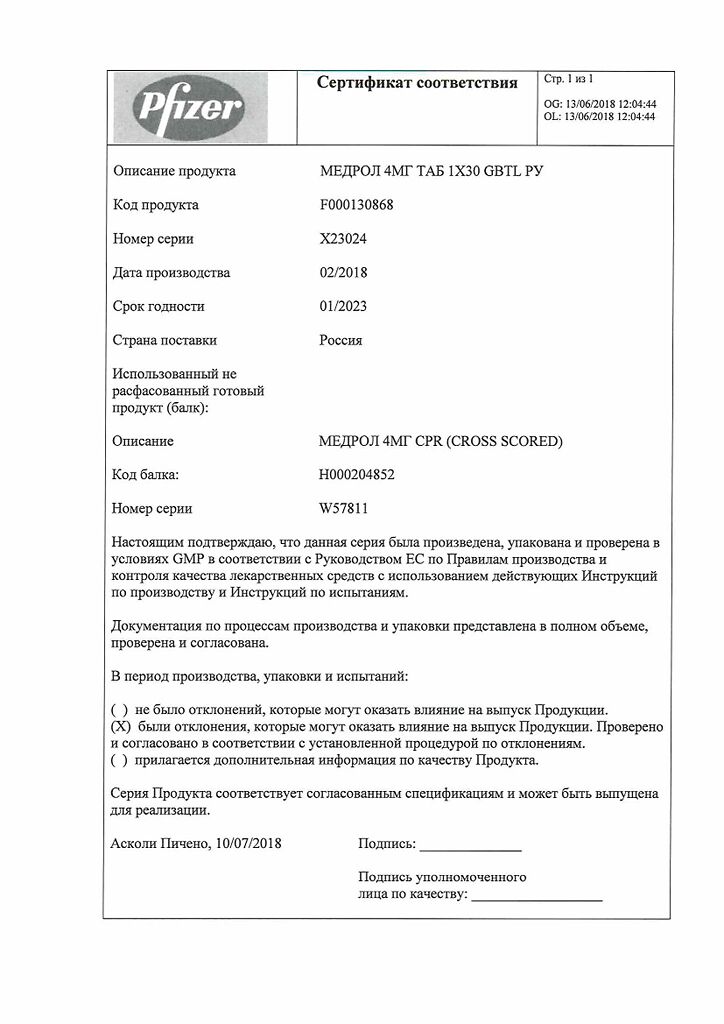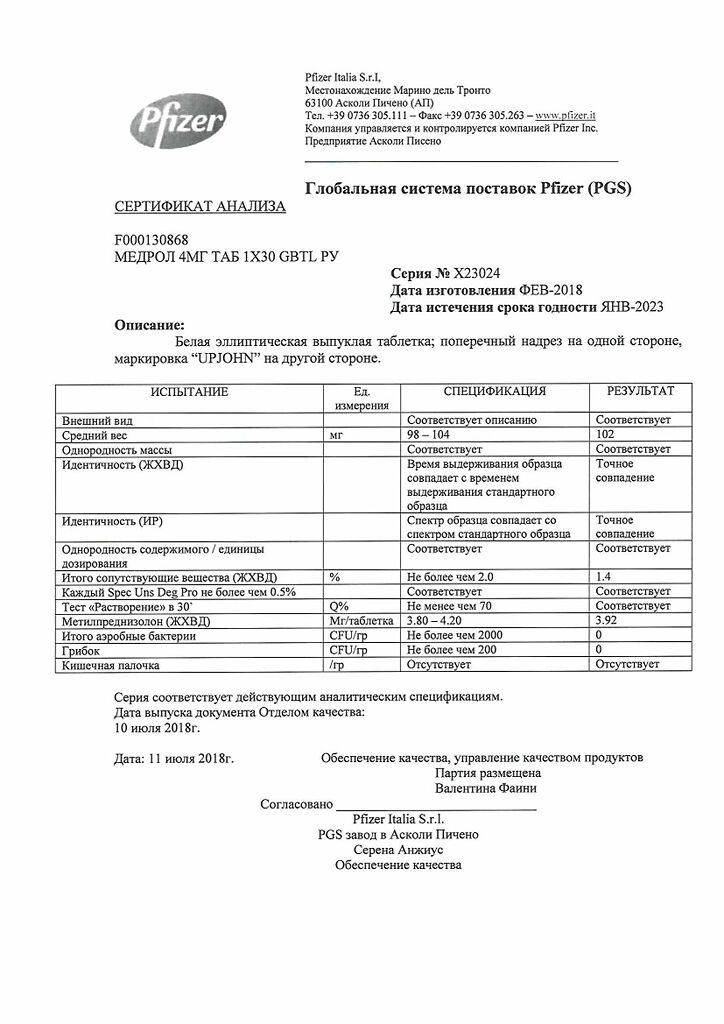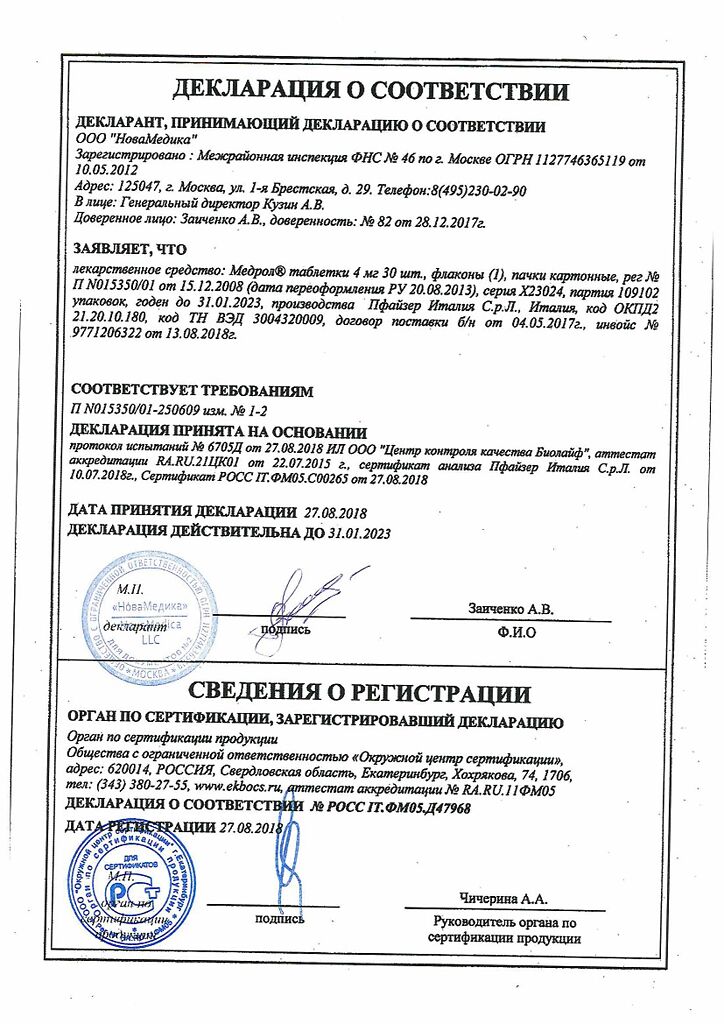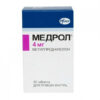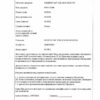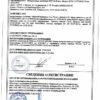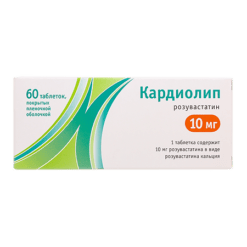No products in the cart.
Medrol, tablets 4 mg 30 pcs
€1.00
Out of stock
(E-mail when Stock is available)
EAN: 4601951000703
SKU: 20381
Categories: Bronchial asthma, Corticosteroid hormones, Medicine, Pain and fever
Description
A synthetic glucocorticoid with anti-inflammatory, anti-allergic, immunosuppressive activity. Under the action of Medrol there is a decrease in the number of immunoactive cells around the inflammatory focus, reduction of vasodilation, stabilization of lysosomal membranes, inhibition of phagocytosis, reduction of prostaglandin and related substances production. Medrol in a dose of 4 mg has the same anti-inflammatory effect as hydrocortisone in a dose of 20 mg.
The drug has minimal mineralocorticoid action (200 mg of the drug is equivalent to 1 mg of deoxycorticosterone).
The drug has a catabolic effect. It reduces glucose uptake by peripheral tissues, which may lead to hyperglycemia and glucosuria, especially in patients predisposed to diabetes.
Medrol has lipolytic effects, mainly in the extremities, also lipogenic effects, most evident in the chest, neck and head, leading to redistribution of fat deposits. It can cause osteoporosis.
Indications
Indications
systemic lupus erythematosus, rheumatoid arthritis
severe psoriasis, neurodermatitis
severe allergic diseases
bronchial asthma
glomerulonephritis.
Pharmacological effect
Pharmacological effect
A synthetic glucocorticoid with anti-inflammatory, antiallergic, immunosuppressive activity. Under the influence of Medrol, there is a decrease in the number of immunoactive cells around the inflammatory focus, a decrease in vasodilation, stabilization of lysosomal membranes, inhibition of phagocytosis, and a decrease in the production of prostaglandins and related substances. Medrol at a dose of 4 mg has the same anti-inflammatory effect as hydrocortisone at a dose of 20 mg.
The drug has minimal mineralocorticoid effect (200 mg of the drug is equivalent to 1 mg of deoxycorticosterone).
The drug has a catabolic effect. Reduces the absorption of glucose by peripheral tissues, which can lead to hyperglycemia and glucosuria, especially in patients predisposed to diabetes.
Medrol has a lipolytic effect, mainly in the extremities, also a lipogenic effect, most pronounced on the chest, neck and head, leading to the redistribution of fat deposits. May cause osteoporosis.
Special instructions
Special instructions
Before starting treatment, the patient should be examined to identify possible contraindications. Clinical examination should include a study of the cardiovascular system, x-ray examination of the lungs, examination of the stomach and duodenum; urinary system, visual organs.
Before and during steroid therapy, it is necessary to monitor a general blood count, the concentration of glucose in the blood and urine, and electrolytes in the plasma. For intercurrent infections, septic conditions and tuberculosis, simultaneous antibiotic therapy is necessary.
Immunizations should not be performed during treatment. With sudden withdrawal, especially in the case of previous use of high doses, GCS “withdrawal” syndrome occurs: decreased appetite, nausea, lethargy, generalized musculoskeletal pain, asthenia.
After discontinuation, relative insufficiency of the adrenal cortex persists for several months. If stressful situations arise during this period, GCS is prescribed (according to indications) for the duration, if necessary – in combination with MCS. Children who during the treatment period were in contact with patients with measles or chickenpox are prescribed specific Ig prophylactically. To reduce side effects, it is justified to prescribe anabolic steroids and increase the intake of K+ from food.
In Addison’s disease, simultaneous administration of barbiturates should be avoided – there is a risk of developing acute adrenal insufficiency (Addisonian crisis).
Use during pregnancy in the first trimester and during lactation: prescribed taking into account the expected therapeutic effect and negative effect on the fetus and child. With long-term therapy during pregnancy, fetal growth is impaired.
In the third trimester of pregnancy, there is a risk of atrophy of the adrenal cortex in the fetus, which may require replacement therapy in the newborn. In children during the growth period, GCS should be used only according to absolute indications and under the particularly careful supervision of the attending physician.
Active ingredient
Active ingredient
Methylprednisolone
Composition
Composition
1 tablet contains:
Active ingredient:
methylprednisolone 4 mg;
Excipients:
calcium stearate;
corn starch;
lactose;
sucrose.
Pregnancy
Pregnancy
The use of Medrol during pregnancy is possible if the expected effect of therapy outweighs the potential risk to the fetus (adequate and strictly controlled safety studies have not been conducted).
Women of childbearing age should be warned of the potential risk to the fetus (corticosteroids cross the placenta).
Breastfeeding women are advised to stop either breastfeeding or the use of drugs, especially in high doses (corticosteroids pass into breast milk and can inhibit the production of endogenous corticosteroids, suppress growth and cause undesirable effects in offspring).
Contraindications
Contraindications
severe arterial hypertension, severe heart failure
diabetes mellitus
peptic ulcer of the stomach and duodenum
mental illness
glaucoma
viral infections
fungal infections
hypersensitivity to the drug Medrol.
Side Effects
Side Effects
From the metabolic side: sodium retention, chronic heart failure in patients with a corresponding predisposition, increased blood pressure, fluid retention in the body, potassium loss and hypokalemic alkalosis, negative nitrogen balance due to protein catabolism.
From the musculoskeletal system: steroid myopathy, muscle weakness, osteoporosis, pathological fractures, vertebral compression fractures, aseptic necrosis of the epiphyses of tubular bones, tendon ruptures, especially the Achilles tendon.
From the digestive system: peptic ulcer with possible perforation and bleeding, gastric bleeding, pancreatitis, esophagitis, intestinal perforation. After treatment with GCS, an increase in the activity of ALT, AST and alkaline phosphatase in the blood serum was observed. Usually these changes are minor, not associated with any clinical syndromes and are reversible after cessation of treatment.
Dermatological reactions: slow wound healing, petechiae and ecchymosis, thinning and decreased strength of the skin.
From the nervous system: increased intracranial pressure, pseudotumor cerebri, mental disorders, convulsions.
From the endocrine system: menstrual irregularities, hirsutism, development of Cushing’s syndrome, suppression of the pituitary-adrenal system, decreased tolerance to carbohydrates, manifestation of latent diabetes mellitus, increased need for insulin or oral hypoglycemic agents in patients with diabetes, growth retardation in children.
From the organ of vision: posterior subcapsular cataract, increased intraocular pressure with the risk of damage to the optic nerve, exophthalmos.
Allergic reactions: hypersensitivity reactions, including allergic systemic reactions, suppression of reactions during skin testing is possible.
Other: blurred clinical picture in infectious diseases, activation of latent infections, the occurrence of infections caused by opportunistic pathogens, GCS withdrawal syndrome.
Interaction
Interaction
Increases the toxicity of cardiac glycosides (due to the resulting hypokalemia, the risk of developing arrhythmias increases). Accelerates the elimination of ASA, reduces its concentration in the blood (when methylprednisolone is discontinued, the concentration of salicylates in the blood increases and the risk of side effects increases).
When used simultaneously with live antiviral vaccines and against the background of other types of immunization, it increases the risk of viral activation and the development of infections. Increases the metabolism of isoniazid, mexiletine (especially in “fast” acetylators), which leads to a decrease in their plasma concentrations. Increases the risk of developing hepatotoxic reactions of paracetamol (induction of “liver” enzymes and the formation of a toxic metabolite of paracetamol). Increases (with long-term therapy) the content of folic acid. Hypokalemia caused by GCS can increase the severity and duration of muscle blockade due to muscle relaxants. In high doses, it reduces the effect of somatropin.
Antacids reduce the absorption of corticosteroids. Reduces the effect of hypoglycemic drugs; enhances the anticoagulant effect of coumarin derivatives. Weakens the effect of vitamin D on the absorption of Ca2+ in the intestinal lumen. Ergocalciferol and parathyroid hormone prevent the development of osteopathy caused by GCS. Reduces the concentration of praziquantel in the blood. Ketoconazole reduces the clearance and increases the toxicity of methylprednisolone.
Combined use with cyclosporine causes mutual inhibition of metabolism – the risk of developing side effects of both drugs (cases of seizures have been reported when used together). Thiazide diuretics, carbonic anhydrase inhibitors, other corticosteroids and amphotericin B increase the risk of hypokalemia, Na+-containing drugs – edema and increased blood pressure. NSAIDs and ethanol increase the risk of developing ulceration of the gastrointestinal mucosa and bleeding; in combination with NSAIDs for the treatment of arthritis, it is possible to reduce the dose of GCS due to the summation of the therapeutic effect.
Indomethacin, displacing methylprednisolone from its association with albumin, increases the risk of developing its side effects. Amphotericin B and carbonic anhydrase inhibitors increase the risk of osteoporosis. The therapeutic effect of GCS is reduced under the influence of phenytoin, barbiturates, ephedrine, theophylline, rifampicin and other inducers of “liver” microsomal enzymes (increased metabolic rate).
Mitotane and other inhibitors of adrenal cortex function may necessitate an increase in the dose of GCS. The clearance of GCS increases against the background of thyroid hormones. Immunosuppressants increase the risk of developing infections and lymphoma or other lymphoproliferative disorders associated with the Epstein-Barr virus.
Estrogens (including oral estrogen-containing contraceptives) reduce the clearance of GCS, prolong T1/2 and their therapeutic and toxic effects. The appearance of hirsutism and acne is facilitated by the simultaneous use of other steroid hormonal drugs – androgens, estrogens, anabolic steroids, oral contraceptives. Tricyclic antidepressants may increase the severity of depression caused by taking corticosteroids (not indicated for the treatment of these side effects).
The risk of developing cataracts increases when used in conjunction with other corticosteroids, antipsychotic drugs (neuroleptics), carbutamide and azathioprine. Simultaneous administration with m-anticholinergics (including antihistamines, tricyclic antidepressants), nitrates contributes to the development of increased intraocular pressure.
Overdose
Overdose
The clinical syndrome of acute drug overdose has not been described. Reports of cases of acute toxicity following an overdose of corticosteroids are extremely rare.
Symptoms: frequent repeated use (daily or several times a week) for a long time can lead to the development of Cushing’s syndrome and other complications characteristic of long-term GCS therapy.
Treatment: symptomatic therapy. Methylprednisolone is eliminated by dialysis. There is no specific antidote.
Storage conditions
Storage conditions
At 20–25 °C
Shelf life
Shelf life
5 years
Manufacturer
Manufacturer
USA
Additional information
| Shelf life | 5 years |
|---|---|
| Conditions of storage | At a temperature of 20-25 °C |
| Manufacturer | Pfizer, Puerto Rico |
| Medication form | pills |
| Brand | Pfizer |
Other forms…
Related products
Buy Medrol, tablets 4 mg 30 pcs with delivery to USA, UK, Europe and over 120 other countries.

